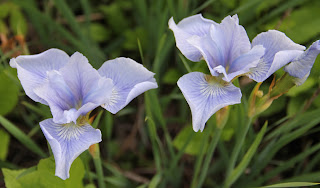Small Gasteria
I have a growing passion for succulent Gasteria. Since I purchased the first in November 2014 I have a collection found in nearly every window of our home.
Gasterias are succulents from South Africa and Namibia. Commonly called Ox or Lawyer Tongue, Gasteria are part of the family Xanthorrhoeaceae, subfamily Asphodeloideae. Closely related to Aloe and Haworthia, they readily cross creating Gasteraloe (Gastrorlea) and Gasterworthia.
The genus Gasteria is comprised of highly variable species. The plant is stemless, leaves are thick, with a waxy surface often banded or dotted with color or warty. The leaves grow from the center in either a linear stack or spiral form. The raceme of flowers are down-facing, orange and green, shaped like stomachs thus the name Gasteria. The blossoms are edible raw or cooked and a component of stews.In my north country they make excellent houseplants, tolerating indirect sunlight or little shade. Some sunlight ensures compact grow. Too much sun will turn leaves to red and then white or yellow.
Water evenly and generously in the summer, letting the soil dry out between watering. Do not let water collect in between leaves. In the winter, reduce watering to every other month, but do not stop watering. The plant is frost hardy to -1°C.
I found it difficult to properly name all plants, Some I purchased were not named, I have not assumed all named varieties are correctly labeled either.
You can see additional pictures of Gasteria on my Pinterest board.
I have a growing passion for succulent Gasteria. Since I purchased the first in November 2014 I have a collection found in nearly every window of our home.
Gasterias are succulents from South Africa and Namibia. Commonly called Ox or Lawyer Tongue, Gasteria are part of the family Xanthorrhoeaceae, subfamily Asphodeloideae. Closely related to Aloe and Haworthia, they readily cross creating Gasteraloe (Gastrorlea) and Gasterworthia.
The genus Gasteria is comprised of highly variable species. The plant is stemless, leaves are thick, with a waxy surface often banded or dotted with color or warty. The leaves grow from the center in either a linear stack or spiral form. The raceme of flowers are down-facing, orange and green, shaped like stomachs thus the name Gasteria. The blossoms are edible raw or cooked and a component of stews.In my north country they make excellent houseplants, tolerating indirect sunlight or little shade. Some sunlight ensures compact grow. Too much sun will turn leaves to red and then white or yellow.
Water evenly and generously in the summer, letting the soil dry out between watering. Do not let water collect in between leaves. In the winter, reduce watering to every other month, but do not stop watering. The plant is frost hardy to -1°C.
I found it difficult to properly name all plants, Some I purchased were not named, I have not assumed all named varieties are correctly labeled either.
You can see additional pictures of Gasteria on my Pinterest board.
 |
| Gasteria nitida monstrosa |
 |
| Gasteria glomerata |
 |
| Hybrid Little Warty |
 |
 |
| Gasteraloe |






















